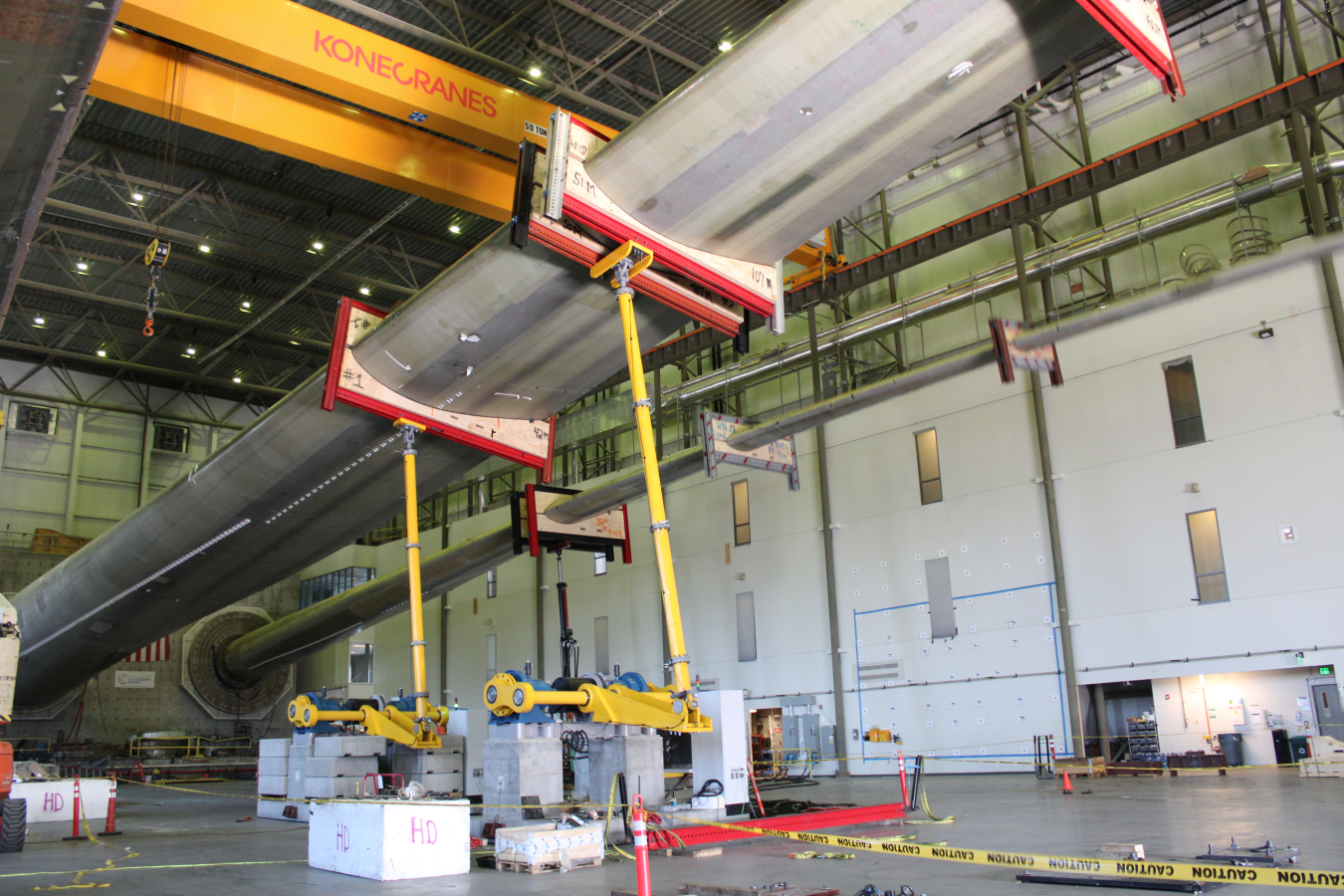Thanks to funding from the Wind Energy Technologies Office, the Massachusetts Clean Energy Center’s Wind Technology Testing Center (WTTC) is testing next-generation wind turbine blades.
Wind Energy Technologies Office
May 21, 2024When the Vineyard Wind 1 project is complete, 62 state-of-the-art wind turbines off the coast of Massachusetts will generate power for more than 400,000 homes and businesses. The turbines are massive and durable, thanks in part to testing at a facility that is one-of-a-kind in North America.
The Massachusetts Clean Energy Center’s Wind Technology Testing Center (WTTC) sits on a deepwater port along Boston's Mystic River. Cranes pluck wind turbine blades from ships and move them into the warehouse-style building. There, they undergo stress tests and analysis to ensure they will perform as expected.
In the early days after the WTTC opened in 2011, it was testing land-based wind turbine blades that typically spanned around 50 meters (164 feet). Today, the WTTC is testing both land-based and offshore wind turbine blades that are growing in size as part of the industry's move toward bigger wind turbines that can harvest more energy at lower wind speeds.
With larger turbines, a wind farm can deliver more energy with fewer turbines.
"If you can get the same power with six fewer machines, there are cost savings all over the map—such as less time installing equipment at sea," said Daniel Beals, program analyst with the U.S. Department of Energy’s Wind Energy Technologies Office (WETO).
This trend is good news for an affordable clean energy future. "But from an engineering standpoint, it gets more and more difficult," said Rahul Yarala, WTTC's executive director. "Turbine blades are getting heavier. They're getting more complicated. So not only do they have to be designed properly, they have to be tested properly as well to have full confidence that they will run smoothly."

The WTTC opened in 2011 and has since evolved to test longer wind turbine blades.
Ready for big future developments
Recent upgrades at WTTC, funded by WETO, enable the facility to receive and evaluate blades up to 120 meters (393 feet) long. The improved testing capability helps expedite the deployment of offshore wind power.
Three prototype blades for the wind turbines used at Vineyard Wind were tested for over a year—the last step before they went into mass production for the project. Without WTTC, the blades would have needed to be tested at a similar facility in Europe, adding time and cost to the project.
"We're trying to get deployable and well-researched projects into the water faster," Beals said.
To start, blades are mounted onto the inside of the facility, like wings sprouting from the wall. In the past, only one installation angle would have been possible. A new wedge plate system enables a blade to be angled anywhere from 0 degrees, or parallel with the ground, to 12 degrees, where the tip is angled toward the roof.
"That way, we're able to apply a load (force or stress applied to a wind turbine blade) at different blade angles," Yarala said. "We can adjust the blade angles to study different worst-case situations, like 50-year wind gusts or Category 5 hurricane wind speeds."
The WTTC team strategically places clamps that apply loads, mimicking the outdoor elements, at different points along the blade. The recent improvements have expanded the number of possible load points (points of potential stress on the blade) from 8 to 11, which is necessary to accommodate the increased blade length.
To a layperson viewing wind turbines from afar, they seem like stiff blades slicing through the breeze. But, like skyscrapers built to handle rough air, wind turbine blades have subtle but remarkable flexibility. Tests at WTTC bend the blades up-and-down and edgewise, or side-to-side. New testing techniques can create the amount of movement, or excitation, needed to test bigger blades.
The tests at WTTC simulates two decades of wear and tear over the course of a few months.
"We apply a load over millions of cycles to simulate the full life of a wind turbine blade in the field," Yarala said. "To do that, we need the exciter systems to be able to provide the required energy input."
A push for even faster, easier blade testing
In addition to the more powerful excitation ability, the new testing techniques can simultaneously move the blade in both flap and edge directions, which is known as biaxial blade testing. While biaxial blade testing is not yet common practice, the facility upgrade has allowed WTTC to develop it further.
"If you do combined loading, it's not only more representative of what's happening in the field, it can also be a quicker test," Yarala said. "The technology is still not quite there, but this equipment moves it significantly forward."
Up to 300 sensors placed along the wind turbine blade transmit data about how the blade responds to forces applied during testing. The WTTC updates also included hardware and software systems that can handle the increase in data that comes with longer blades.
The funding award from WETO also enabled a partial design and cost estimate for expanding the physical WTTC space. Turbine blades are beginning to outgrow the existing 90-meter building, requiring researchers to cut the tips off blades to bring them inside for testing. An expansion would make the building both longer and taller to allow for ultralong blades and bending space.
“Even a small repair on a turbine blade offshore can be costly,” Yarala said. “At WTTC, we can test it and preemptively avoid as many issues as possible, saving money down the line."
WETO has a rich history of leading innovation efforts to improve wind turbine blades. In addition to saving on costs, the testing helps expedite the use of larger and more efficient blades as the blades are ready for deployment after testing. That means more wind energy per turbine, a key way to help the United States reach its goal of deploying 30 gigawatts of offshore wind energy by 2030.

